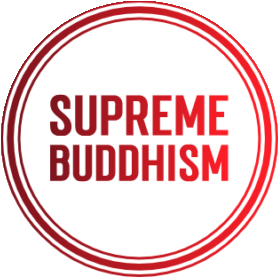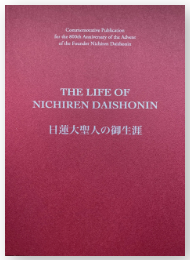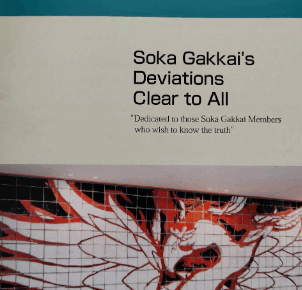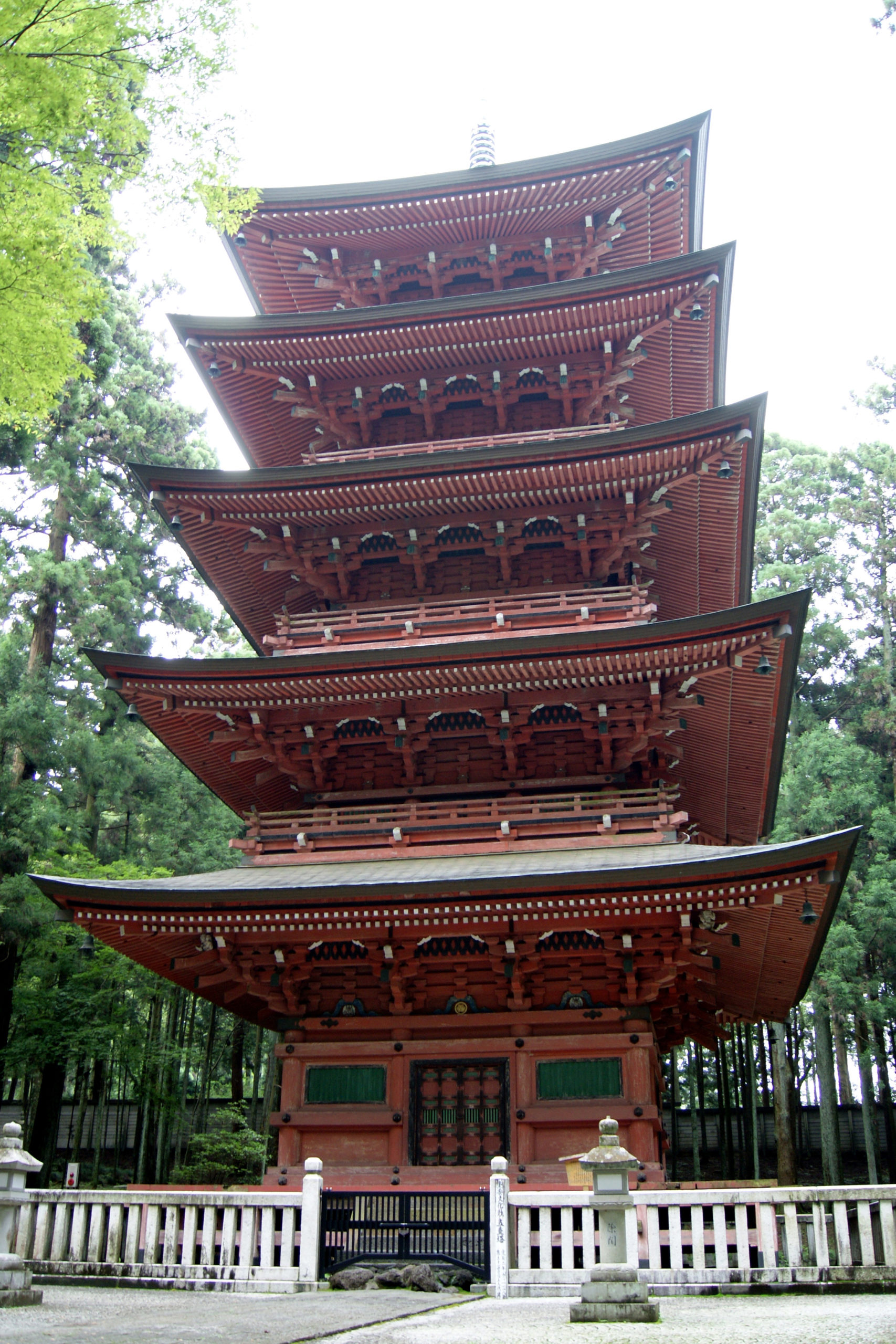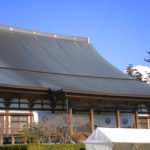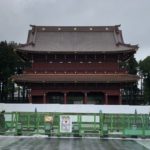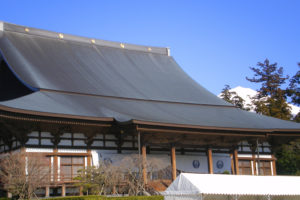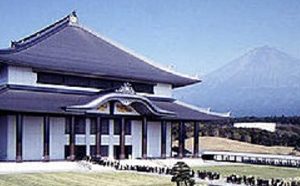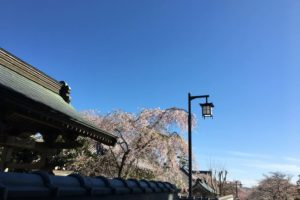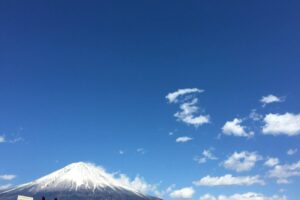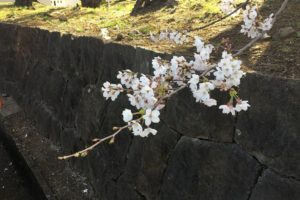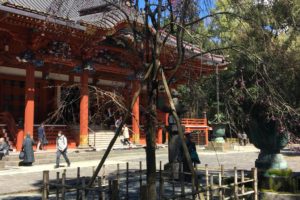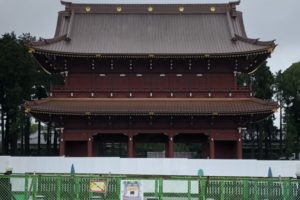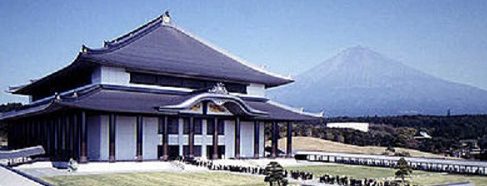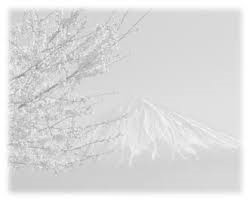Contents
- Lecture on the Rissho Ankoku Ron (Part 7)
- 1. Prohibition of offering alms to the icchantika
- 2. Three types of sins concerning the act of killing
- 3. Three forms of entrustment
- 4. King Utoku and the Priest Kaku- toku
- 5.The Sole Selection of Nembutsu” (Senchaku-shu) of Honen: the evil source that sought to destroy the Buddha, the Caw and the Priesthood
Lecture on the Rissho Ankoku Ron (Part 7)
Today, we will discuss the seventh stage of the Rissho ankoku-ron, the treatise. “On Securing the Peace of the Land through the Propagation of True Buddhism.”
In the seventh stage of this treatise, the question and answer exchange between the guest and the host concerns the means by which to put an end to the extensive slandering of the Law and to do away with evil monks and other such people.
Previously, the guest had asked the host: “If, indeed, Honen’s teachings con-stituted slander, then were there petitions presented to the feudal government or to the emperor concerning his doctrines?” In response, the host said that an imperial rescript and a shogunal mandate were set forth according to the repeated demands from Enryaku-ji and Kofuku-ji temples.As a result, the wood blocks used in print-ing “The Sole Selection of Nembutsu” (Senchaku-shu) of Honen were burned, and Honen’s grave was dug up and destroyed. Hearing this response from the ho st, the guest, who had heretofore embraced the Nembutsu doctrines, gradually eased his resentment against the host, who spoke to him in a reasonable and systematic manner.The seventh stage is presented at this point.The guest asked the host the following.
Between you and Honen, I cannot tell which is wise and which is foolish, or determine whose assertions are right and whose are wrong.
However, you assert that all the recent disasters are to be traced to the Senchaku shu of Honen…. Now surely the peace of the world and the stabil-ity of the nation are sought by both ruler and subject and desired by all the inhabitants of the country….One must first of all pray for the safety of the nation and then work to establish the Buddhist Law. Now if you know of any means when disasters can be prevented and troubles brought to an end, I would like to hear about it. (Gosho, p. 244; MW-2, p. 31)
This passage shows that the guest’ s focus was still centered on secular concerns.He was still unable to understand that true peace and tranquility in the nation could only be achieved by discarding heresy and upholding True Buddhism.
The host, who represented Nichiren Daishonin, instructed that stopping those who slander the Law and paying respect to the priests who lead people to the Correct Way are the only means to assure stability within the nation and peace in the world.
Next, the host selected passages from the Nirvana Sutra and the Lotus Sutra to explain the tremendous importance of stopping the proliferation of heresy and protecting True Buddhism.
1. Prohibition of offering alms to the icchantika
The Daishonin states:
With the exception of one type of person, the icchantika, you may offer alms to all kinds of persons, and everyone will praise you.(Gosho, p. 244; MW- 2, p. 32)
Nichikan Shonin wrote the following in his Mondan:
The icchantika do not represent people outside our surroundings. They signify the four types of people who are associated with Buddhism. In this passage, the icchantika refer to those who slander True Buddhism and do not repent.(Mondan, p. 38)
The icchantika were the four types of followers (priests, nuns, lay men and lay women) who slandered True Buddhism. He further explained:
Let me describe the icchantika.There are three types: the first are the icchantika who slander; the second are the icchantika who commit grave offenses; and the third are the icchantika who manifest no sense of repentance.(Mondan, p. 39)
#1. The slanderous icchantika were those “who spoke careless and evil words and slandered the True Law.” (Gosho, p. 244; MW-2, p. 33) These were individuals who slandered True Buddhism.
#2. The icchantika who committed grave offenses were “those who committed the four grave offenses or were guilty of the five cardinal sins.” (Gosho,p. 244; MW-2, p. 33) These icchantika repeatedly committed the four grave offenses (killing, stealing, committing adultery and lying) and the five cardinal sins (killing one’s father, killing one s mother, killing an arhat, injuring a Buddha and causing disunity among believers).
#3. The icchantika who manifested no repentance were those who “showed no inclination to reform or any sign of repentance in their hearts.” (Gosho, p. 244; MW-2, p. 33 ) These icchantika did not regret their sins, and they did not endeavor to change their negative ways.In fact, they dared to make light of True Buddhism and criticized it.
Moreover, the icchantika who committed grave offenses and those who manifested no repentance were unable to believe in the True Law.As a result, they slandered True Buddhism and committed the four grave offenses and five cardinal sins., they were unable to promptly repent of their behavior.For this reason, the slanderous icchantika were included in the categories of the icchantika who committed grave offenses and the iechantika who manifest no repentance.To offer alms to the slanderous icchantika would cause one to fall into the hell of incessant suffering (Avichi hell), and would bring ruin to the country.
2. Three types of sins concerning the act of killing
Killing an icchantika did not configure the commission of one of the three types of sins.The Daishonin stated:
There are three degrees of killings: the lower, middle and upper degrees.(Gosho, p. 244; MW-2, p. 34)
Nichikan Shonin wrote:
The suffering of the lower degree is the slightest. The suffering of the upper degree is the most severe, and the suffering of the middle degree is moderate.(Mondan, p. 39)
#1. The lower degree signified the killing of the lesser creatures, from a small ant to all the animals.However, excluded from this group were the bodhisattvas who manifested themselves in the form of animals, for the sake of instructing the people.
# 2. The middle degree referred to the kill-ing of common mortals.In both the lower and middle degrees, the offend-ers would fall into the life conditions of Hell, Hunger and Animality and they would suffer the consequences of such karmic causes.
# 3. The upper degree represented the kill-ing of one’s parents, an arhat, a person who had reached the state of pratyeka- buddha (Realization) or a bodhisattva. As a result of this crime, the killer would fall into the hell of incessant suffering.
However, it was written:
If someone were to kill an icchantika, that killing would not fall into any of the three categories just mentioned.(Gosho, p. 245; MW-2, p. 34)
Thus, according to this sutra, the kill-ing of an icchantika was not an act that was considered to be one of the three types of sins. Since the fundamental source of all misfortune was slandering True Buddhism, the act of eliminating the icchantika, the essential source of this evil, the three types was not included of sins.
3. Three forms of entrustment
Citing a passage from the Sutra of the Benevolent King (Ninno-kyo), the Daishonin stated:
Thus, I entrust the protection of my teachings to the ruler of the nation rather than to the monks and nuns (Gosho, p. 245; MW-2, p. 34)
Nichikan Shonin wrote:
There are three forms of entrustment. The first is entrustment through propagation. The second is through initiative instruction. The third is through support and protection. .. At the current time, the third form-entrustment through support and protection-prevails.(Mondan, p. 39)
Nichikan Shonin thus described the three forms of entrustment.
#1. Entrustment through propagation signified the dissemination of Buddhism according to the times or the capacity of the people.
# 2. Entrustment through initiative instruc tion represented the process of correctly receiving and transmitting Buddhism into the eternal future, based on the mutual relationship between the master and disciple.
# 3. Entrustment th rough support and protection described the sovereigns and the lay supporters of Buddhism who protected the Law according to the times to prevent its extinction.
The passage concerning the “entrustment of the teachings to the ruler of the nation” referred to the act of entrustment through support and protection i which the sovereign, based on his power protected Buddhism.In other word, in contrast to the entrustment through propagation and that through initiative instruction, which targeted priests, this entrustment through support and protection was aimed at the lay believer.
4. King Utoku and the Priest Kaku- toku
In order to defend the Law, he went at once to the place where the monk was preaching the Law and fought with all his might against the evil monks who did not observe the precepts (Gosho, p. 245; MW-2, p. 36)
The Nirvana Sutra described King Utoku, who did not begrudge his life to protect the priest Kakutoku, who upheld the Buddhist precepts.
Nichikan Shonin wrote the following about the story of Utoku and Kakutoku:
Utoku defended the Law and was injured in the struggle. Since he upheld the Law above his own life, he achieved his position as the foremost disciple.Kakutoku upheld the precepts and expounded the Law. In his position, he depend ed on the authority of the king.Thus, he became the second significant disciple.(Mondan, p. 40)
Nichikan Shonin explained how the king and the priest turned out to be the primary and secondary disciples respectively.In this story, the priest Kakutoku, who upheld the precepts and protected True Buddhism, was propagating the Law.At the time numerous resentful, evil monks whe practiced heretical precepts attempted to kill Kakutoku with swords and staves.When King Utoku got wind of this situation, he fought with the slanderous evil monks, to defend the priest Kakutoku.The king sustained mortal wounds throughout his entire body, but he still continued to defend the priest Kakutoku , upholding the spirit of not begrudging his life for the sake of the Law.At that time, the master priest Kakutoku said to the king, “Since you have continued to protect True Buddhism, your life will infinitely manifest the entity of the Law in future lifetimes.” Hearing this, the king felt great joy and solemnly died a martyr.utter, the king was reborn in the land of Ashuku Buddha and became that Buddha’s primary disciple.The priest Kakutoku became the Buddha’ s second disciple.The sutra went on to explain that King Utoku represented Shakyamuni in the present and the priest Kakutoku was Kasho. Thus, the sutra explained how, based on karmic cause, those who did not begrudge their lives for the sake of True Budd hism were able to achieve an absolutely invincible Dharma body.
In the present passage, Nichiren Daishonin, as represented by the host, strenuously emphasized to Hojo Tokiyori, the significance of the protection and entrustment of True Buddhism and the Importance of defending True Buddhism, manifesting King Utoku’s spirit of not begrudging one’s life for the sake of the Law.
5.The Sole Selection of Nembutsu” (Senchaku-shu) of Honen: the evil source that sought to destroy the Buddha, the Caw and the Priesthood
Are they not destroyers of the Buddha? Are they not destroyers of the Law? Are they not destroyers of the Priesthood? And all their heretical teachings derive from the Senchaku- shu! (Gosho, p. 247; MW-2 , p. 39)
The host made the declaration here that “The Sole Selection of Nembutsu” (Senchaku-shu) of Honen was the evil source that sought to destroy the Buddha, the Law and the Priesthood.
Nichikan Shonin wrote:
In a different edition, I have seen the phrase, “Are they not destroyers of the entire nation?” written below the above passage.(Mondan, p. 43)
Thus, Nichikan Shonin explained that this was, indeed, a karmic cause that was destroying the nation.
In the seventh stage of the Rissho ankoku-ron, the guest stated:
Now if you know of any means when disasters can be prevented and troubles brought to an end, I would like to hear about it.(Gosho, p. 244 MW-2, p. 32)
In response, the host said:
Prohibiting those who slander the Law and paying respect to monks who follow the Correct Way is the best way to assure stability within the nation and peace in the world at large.(Gosho, p. 247; MW-2, p. 39)
Thereafter, the host made reference to the Nirvana Sutra (Nehan-kyo) and the Sutra of the Benevolent King (Ninno-kyo) and indicated the following:
# 1. The people must prohibit the offering of alms to slanderous sects, nuch as Nembutsu, Zen and Shingon, the entities of icchantika who slander True Buddhism.
# 2. Prohibiting the offering of alms to slanderous entities referred to the elimination of such parties.The killing of the icchantika is not characterized as one of the three degrees of killing.
# 3. There are three forms of entrustment. The laity who supports Buddhism is responsible for protective entrustment.
# 4. Those who possess power and are in the position of control over others such as through the use of swords and staves-must protect True Buddhism, as King Utoku did, upholding the spirit of not begrudging one’s life for the sake of the Law.
# 5. The prime evil source of the destruction of the Buddha, the Law and the Priesthood is contained in “The Sole Selection of Nembutsu” (Senchaku- shu) of Honen.
Thus, the host declared that the only way that the nation and the entire world could enjoy peace and stability was through the elimination of slanderous causes, which are the fundamental source of all misfortune.
Moreover, in the passage that followed, the host strictly admonished that those who slander True Buddhism will inevitably fall into the hell of incessant suffering:
The Lotus Sutra reads: ” If a person fails to have faith but instead slanders this sutra, he will eliminate the seed of Buddhism for the entire world, When his life comes to an end, he will enter the Avichi hell, the hell of incessant suffering.” (Gosho, p. 246; MW-2, p. 22)
The host (who represented Nichiren Daishonin, the True Buddha) sought to save the guest (who represented Hojo Tokiyori and the populace who were in a state of delusion).As shown in the following passage, there is a stark distinction between those who believed in True Buddhism (those with a direct karmic bond ljun’en]) and achieved enlightenment and those who slandered (those with an indirect karmic bond (gyaku-en]):
To begin with, the Lotus Sutra was taught to lead all people to enlightenment.However, only those who have faith in it attain enlightenment. Those who slander it fall into the hell of incessant suffering- (Gosho, p. 905; MW-1, p. 157)
In stage seven, the host stated that slander was the sole cause for calamities and the destruction of the nation. He pointed out that “The Sole S election of Nembutsu” (Senchaku-shu) of Honen, with its instructions to “discard, close, ignore and abandon” the Lotus Sutra, was a particularly evil source of slander. He taught that alms should not be presented to those who commit this slander, and that such sources should be eliminated.
The host taught that the sins of this slander were greater than those of a criminal who committed the five cardinal sins.For example, if you gave assistance to an individual who committed a crime, you would be accountable tor the same crime, even if you, yourself,did not commit the murder or robbery. Nichiren Daishonin’s Buddhism is based on tremendous compassion. Thus, elimination does not directly signify the termination of the evil monk’s life; it refers o the clear revelation of the distinction between truth and heresy, the strict instruction based on Buddhist doctrine and the elimination of the fundamental sources of the heretical teachings and monks.
The Daishonin wrote the following:
If you try to treat someone’s illness without knowing what the cause of the illness is, you will only make the person sicker than before. (Gosho, p. 1067; MW-1, p. 193)
If a physician does not know the actual cause of an illness, but still treats a patient, the illness will worsen.In the same way, if an evil monk propagates his teachings, calamities and misfortune will befall the people who believe in his doctrines and they will bring ruin to the nation.The will all face destruction., in the treatise, the host instructed the guest that he and t he lay believers must prohibit the offering of alms to slanderous priests. They must protect (defend and entrust) True Buddhism, as it was done by King Utoku.
